When choosing ceramic pans for your solar kitchen, you'll want to focus on dark-colored options with multi-layered construction and tight-fitting lids. Look for pans featuring Thermolon™ coating, which retains heat up to 95% longer than aluminum and withstands temperatures up to 850°F without toxic fumes. GreenPan's sustainable manufacturing and superior heat retention make it an excellent choice for solar cooking. You'll need pans that can maintain steady temperatures between 150-225°F during peak sunlight hours (11 AM to 3 PM). Position your cookware to maximize sun exposure and use thermal mass for consistent results. The right ceramic pan can transform your solar cooking experience.
Ceramic Pans Meet Solar Energy
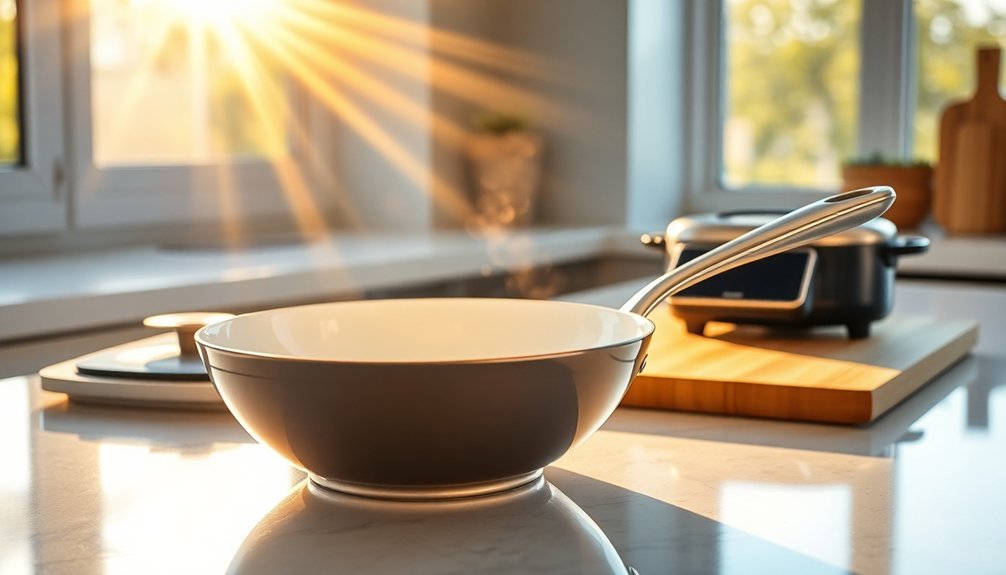
While traditional cookware manufacturing often carries a heavy environmental footprint, ceramic pans are leading the way in sustainable kitchen solutions, particularly when paired with solar energy.
You'll find manufacturers like GreenPan already embracing solar power, with 30% of their factory's energy coming from rooftop panels. Their Thermolon™ coating releases 60% less CO2 than conventional nonstick surfaces.
Your ceramic pan will work efficiently with various heat sources in your solar-powered kitchen, including gas, electric, and ceramic glass stovetops. The coatings are exceptionally safe, as they can withstand up to 850°F without releasing toxic fumes.
If you've got an induction cooktop, look for options with special bases like Magneto™ or Kyocera's circular induction plate.
You'll save energy while cooking too, as ceramic pans heat evenly and retain warmth longer, letting you cook at lower temperatures without sacrificing performance.
Solar Heat Retention Properties
Your ceramic pan's exceptional ability to store heat for up to 30 minutes after removal from solar exposure makes it perfect for sustainable cooking.
The pure ceramic construction made from minerals and clay ensures superior insulation properties for optimal solar cooking performance.
You'll notice the pan's unique design distributes solar-generated heat evenly across its surface, preventing hot spots that could burn your food.
The specialized ceramic material absorbs solar energy at a rate of 75% efficiency, converting sunlight into usable cooking heat that's maintained consistently throughout your meal preparation.
Maximum Heat Storage Duration
Because ceramic pans excel at retaining heat, they'll keep your food warm long after you've removed them from the stove. Your ceramic cookware will retain heat up to 95% longer than aluminum and 50% longer than cast iron, making it ideal for energy-efficient solar cooking. Made from clay and earth minerals, ceramic cookware provides exceptional heat retention while ensuring no harmful metal leaching occurs during extended cooking times.
By using low to medium heat settings, you'll maximize the pan's natural insulating properties while ensuring even heat distribution.
- Pure ceramic cookware offers the best heat retention properties, outperforming ceramic-coated alternatives with metal substrates.
- You'll achieve peak heat storage by slowly heating your pan and allowing it to cool naturally to room temperature.
- For maximum heat retention benefits, avoid exposing your ceramic cookware to sudden temperature changes or excessive heat levels.
Efficient Temperature Distribution Pattern
The remarkable temperature distribution pattern of ceramic pans sets them apart in solar cooking applications. You'll find that ceramic absorbs heat slowly but distributes it uniformly across the cooking surface, eliminating hot spots that can burn your food. The material's far-infrared energy guarantees your ingredients cook evenly from inside out. Since ceramic is made from natural clay materials, its heat-handling properties come from the earth itself, making it an environmentally conscious choice.
| Feature | Benefit | Solar Cooking Impact |
|---|---|---|
| Even Heat Distribution | No hot spots | Consistent results |
| Far-infrared Energy | Inside-out cooking | Better nutrient retention |
| Slow Heat Absorption | Steady temperature | Maximizes solar energy |
| High Heat Retention | Extended cooking time | Reduced energy needs |
These distribution patterns make ceramic pans ideal for solar cooking, as they'll maintain steady temperatures and won't require constant heat adjustments. The uniform heating also helps preserve your food's natural moisture and nutrients.
Solar Energy Absorption Rate
When selecting a ceramic pan for solar cooking, you'll benefit from remarkable advancements in solar absorption technology. Modern ceramic pans now incorporate specialized nanostructures and high-entropy materials that dramatically increase solar energy absorption rates.
These innovations allow your pan to capture up to 87% of available sunlight, converting it efficiently into cooking heat.
- Dark-colored ceramic surfaces enhanced with rare earth elements maximize solar absorption while reducing heat reflection
- Advanced nanostructured ceramics distribute and retain heat evenly across the cooking surface
- Multi-component ceramic designs trap solar energy more effectively than traditional single-phase materials
Your ceramic pan's ability to absorb and retain solar energy directly impacts cooking performance.
Look for pans featuring these latest ceramic technologies, especially when combined with tight-fitting lids and proper insulation, to achieve ideal results in your solar cooking adventures.
Choosing Solar-Ready Ceramic Cookware
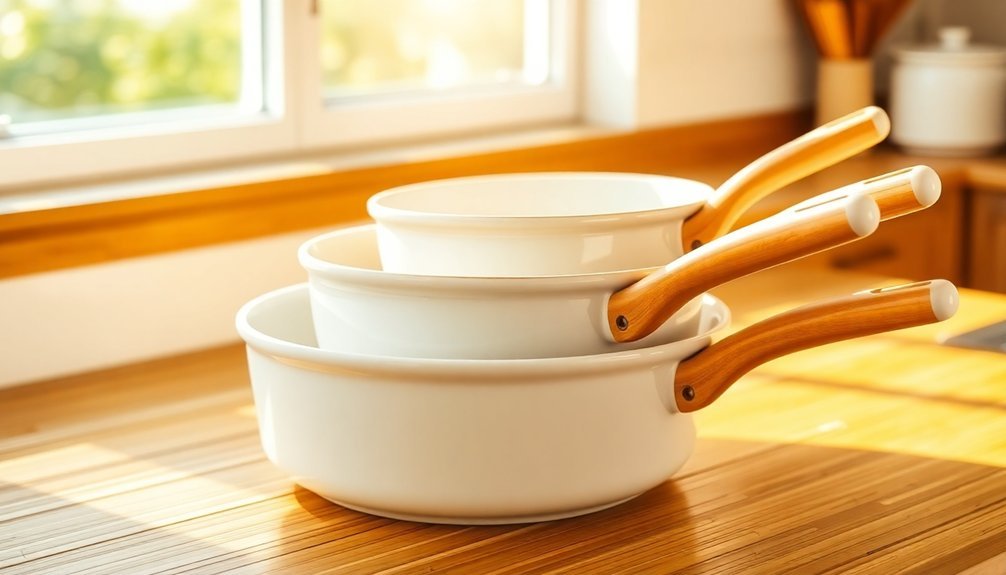
When selecting ceramic cookware for solar cooking, you'll want pans that excel at heat retention while remaining lightweight enough for easy handling.
Your ideal choice should feature aluminum-clad construction that quickly responds to temperature changes, allowing precise control during solar cooking sessions.
Look for pans that are oven-safe up to 550°F, as they'll withstand the concentrated heat from solar cooking while maintaining their durability and nonstick properties.
Heat Retention Capabilities
Since effective heat retention plays an essential role in solar cooking, choosing the right ceramic cookware can make or break your culinary results.
You'll want to look for pans with multi-layered construction, particularly those featuring stainless steel clad bases or 5-ply designs that maximize heat distribution and retention. The ceramic coating's silicon dioxide composition, combined with a quality base material, guarantees your food cooks evenly without hot spots.
- Choose dark-colored ceramic cookware for better solar energy absorption and heat retention during longer cooking periods.
- Look for pans with stainless steel discs on the bottom, as they provide superior heat distribution compared to pure aluminum bases.
- Confirm your ceramic cookware is oven-safe up to at least 550°F to handle the high temperatures achieved in solar cooking.
Lightweight Yet Durable Construction
While solar cooking demands specialized equipment, you'll find that modern ceramic cookware strikes an ideal balance between portability and durability. The lightweight construction makes it easy to maneuver your pans between your solar cooker and kitchen, while the one-piece ceramic design guarantees they'll withstand frequent temperature changes.
| Feature | Benefit |
|---|---|
| Scratch-resistant surface | Maintains appearance through daily use |
| One-piece construction | Prevents weak points and guarantees longevity |
| Heavy metal-free | Safe for food preparation at high temperatures |
You'll appreciate how these pans won't strain your arms during cooking sessions, yet they're tough enough to handle extreme temperatures. The durable ceramic coating won't leach toxins into your food, making them perfect for health-conscious solar cooking enthusiasts who want safe, reliable cookware that's built to last.
Optimal Temperature Control Features
Because temperature control plays a vital role in solar cooking, choosing ceramic cookware with advanced heat management features can greatly improve your results.
You'll want pans that offer ideal heat distribution, often achieved through aluminum bases, and temperature indicators like Tefal's Thermo-Spot technology to help you identify when your pan reaches the perfect cooking temperature.
Look for pans that are compatible with multiple cooking surfaces and offer oven safety, as this versatility will let you adapt when sun conditions aren't ideal.
- Select pans with aluminum or multi-layer bases to guarantee even heating, essential for consistent results in variable solar conditions.
- Check for temperature indicators that help you monitor and maintain ideal cooking zones.
- Verify oven-safe ratings up to at least 350°F for flexibility during cloudy weather or evening cooking.
Temperature Control During Sunlight Hours
As sunlight streams through your kitchen windows, maintaining proper temperature control with ceramic pans becomes especially important.
You'll want to start with low to medium heat, as direct sunlight can add ambient warmth to your cooking space. Since ceramic pans retain heat 95% longer than aluminum, you don't need high temperatures to achieve excellent results.
Watch for signs of overheating, particularly during peak sunlight hours when your kitchen may be naturally warmer. If you're using an electric skillet, keep temperatures below 425°F.
Remember that these pans excel at even cooking through their superior heat retention and far-infrared energy emission. When adjusting temperatures, do so gradually to prevent thermal shock.
You'll find that your ceramic pan maintains consistent heat for up to 7 minutes after reducing the temperature.
Adapting Recipes For Solar Cooking
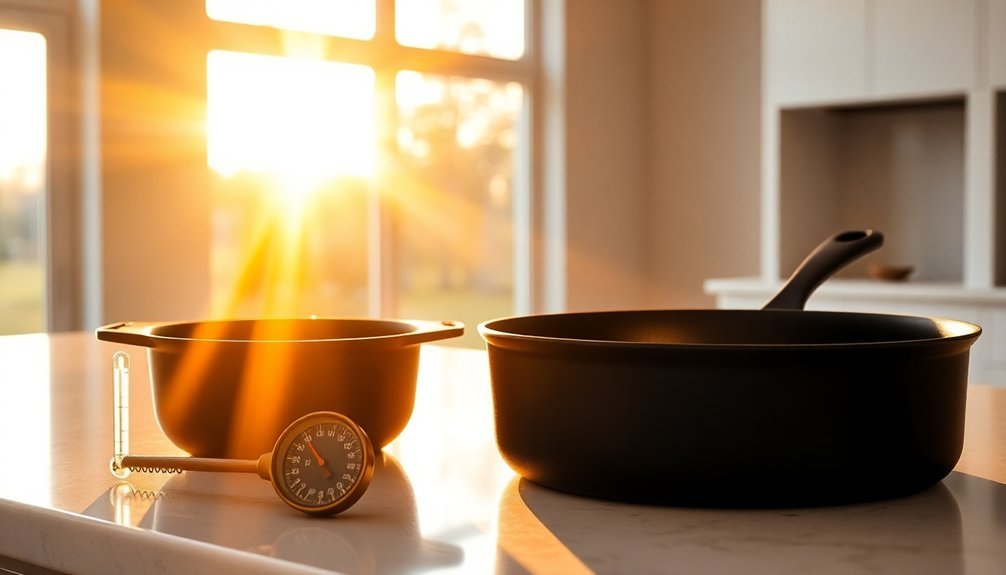
You'll find that successful solar cooking requires careful attention to temperature control throughout the day, especially as sunlight intensity changes.
Your cooking times need adjustment based on factors like cloud cover, ambient temperature, and the position of your solar cooker relative to the sun.
Temperature Control Tips
While traditional recipes require standard oven temperatures, adapting them for solar cooking demands careful attention to temperature control and timing.
You'll need to monitor your ceramic pan's temperature regularly using a reliable thermometer, aiming for the ideal range of 150-225°F. Position your solar cooker to face the sun directly and adjust it every 30-45 minutes to maintain consistent heat throughout the cooking process.
- Use dark-colored ceramic pans with tight-fitting lids to maximize heat absorption and maintain steady temperatures
- Create a greenhouse effect by placing your ceramic pan inside a clear oven bag or under a glass cover
- Protect your cooking setup from wind interference by choosing a sheltered location, as drafts can greatly impact temperature stability
Cooking Time Adjustments
Successful solar cooking requires significant adjustments to standard recipe timelines and methods.
You'll need to extend cooking times by 1½ to 3 times longer than conventional recipes, and reduce liquids by ¼ to ½ cup since less evaporation occurs in solar cookers.
To optimize your cooking schedule, start your prep between 10 AM and 3 PM when sunlight is strongest. Position your ceramic pan to face the sun at noon, and remember to adjust its position every 30-45 minutes for maximum exposure.
Start noontime meals by 9 AM and dinner preparations by 1 PM.
Choose recipes that can simmer slowly, like stews and casseroles. When baking, leave breads and cookies uncovered but keep other dishes lidded.
You'll find that while timing may be less precise, the longer cooking process actually helps tenderize meats and enhance flavors.
Essential Solar Baking Features
When baking with solar power, proper positioning and temperature management become critical factors for success. You'll need to place your ceramic pans in a well-insulated solar oven that faces directly toward the sun, adjusting its position every 30-45 minutes to maintain ideal exposure.
To achieve the best results, use dark-colored, lidded ceramic cookware that maximizes heat absorption while keeping temperatures steady between 150-225°F.
- Choose a sheltered location protected from wind, and make certain your oven's glass and reflective surfaces stay clean for maximum efficiency.
- Preheat your solar oven for at least 20 minutes to reach 300°F before placing your ceramic cookware inside.
- Layer your oven with multiple insulating materials like crumpled newspaper or dry leaves to maintain consistent baking temperatures throughout.
Maximizing Solar Heat Distribution
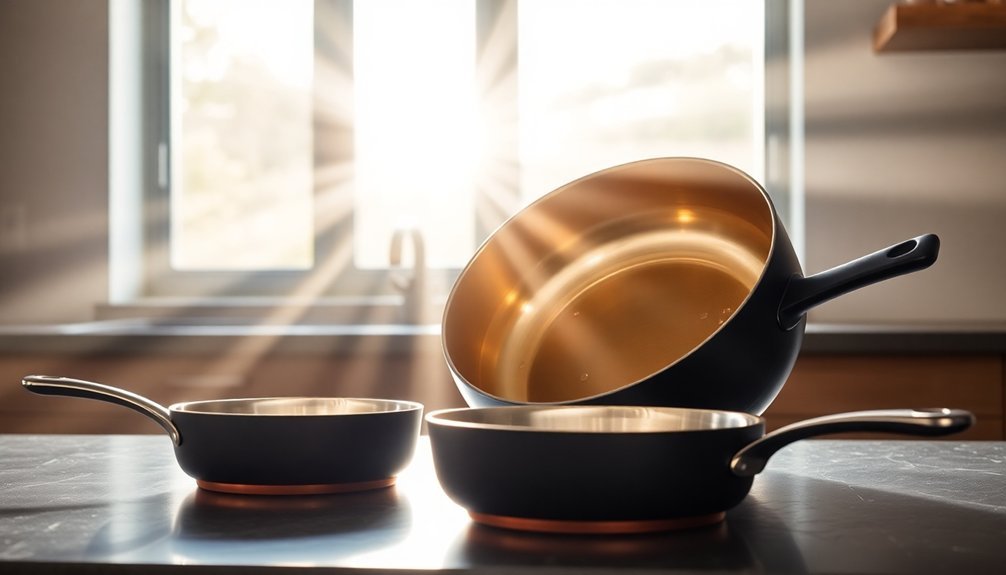
To maximize your solar cooking efficiency, ceramic pans offer superior heat retention and distribution capabilities that make them ideal for solar-powered cooking.
You'll benefit from ceramic's ability to maintain medium heat for up to 7 minutes after reducing temperature, making it perfect for solar ovens where heat fluctuations are common.
Choose pans with a stainless clad base and Thermolon™ ceramic coating, as they'll provide the most even heat distribution.
The far-infrared energy emitted by ceramic cookware helps retain your food's natural moisture, while the coating's superior conductivity lets you cook at lower temperatures.
To enhance performance, use high smoke point oils like canola or grapeseed, and always cook on low to medium heat.
The non-reactive surface won't alter food taste or release harmful chemicals, ensuring safe, efficient solar cooking.
Seasonal Solar Cooking Considerations
Since solar cooking effectiveness varies throughout the year, understanding seasonal adjustments will maximize your ceramic pan's performance.
You'll need to adapt your cooking schedule around peak hours of 11 AM to 3 PM, when the sun's intensity is highest. During winter months, you'll face shorter daylight hours and lower sun angles, requiring more frequent adjustments to maintain ideal temperatures.
- Place your solar cooker in a wind-protected spot and use thermal mass like rocks to retain heat, especially during colder months.
- Track the sun more vigilantly in winter, and keep the oven closed to preserve heat – use steam as your cooking progress indicator.
- Take advantage of summer's longer peak hours for unattended cooking, but remember to preheat your oven regardless of season.
Optimal Pan Colors
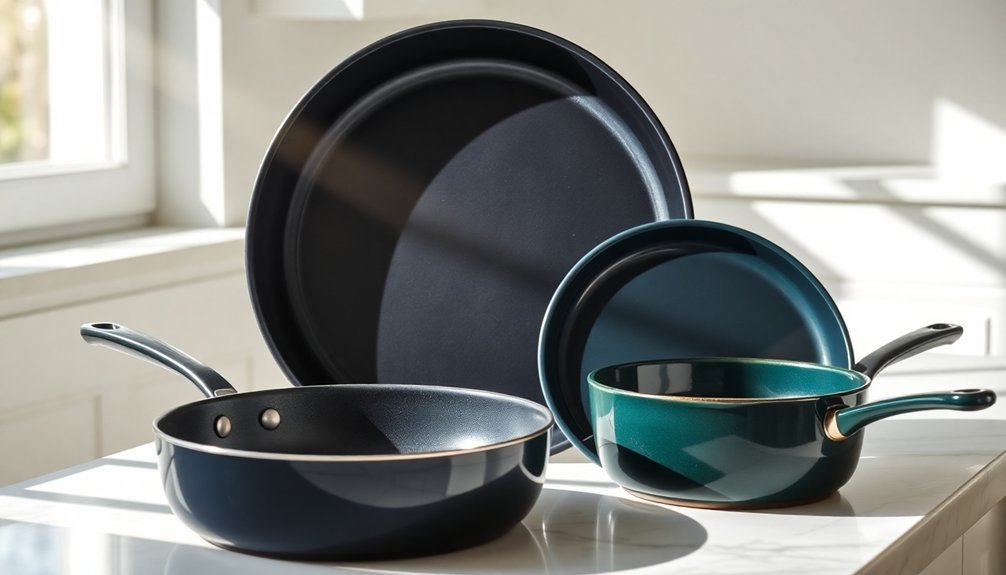
Dark colors play an essential role in maximizing your ceramic pan's solar cooking efficiency.
You'll want to choose matte black or dark-colored ceramic cookware since they convert sunlight into heat energy more effectively than light-colored alternatives. Shiny or reflective surfaces won't work well as they deflect valuable sunlight away from the cooking surface.
If you're considering ceramic pans for solar cooking, make sure they're specifically darkened.
You can even enhance lighter pans' performance by applying dark spray paint. While conventional ceramic cookware comes in various colors, for solar cooking, stick to black or dark options.
When using your dark ceramic pans, pair them with clear covers or oven bags to retain heat, and don't forget to rotate your solar cooker to follow the sun's path for best results.
Safe Handling In Sunlight
While dark-colored ceramic pans excel at solar cooking, proper handling becomes a priority when working with them in direct sunlight.
You'll need to manage heat carefully since sunlight can create intense temperatures that may affect your pan's performance. When cooking outdoors, it's best to use moderate heat settings and high smoke point oils like coconut or grapeseed to protect the ceramic coating.
- Always use wooden or silicone utensils, as metal tools can scratch the surface more easily when the pan is hot from sun exposure.
- Keep your pan protected from sudden temperature changes by avoiding cold water contact when it's sun-heated.
- Clean your sun-warmed pan only after it's cooled down, using mild soap and a soft sponge to preserve its nonstick properties.
Winter Solar Cooking Tips
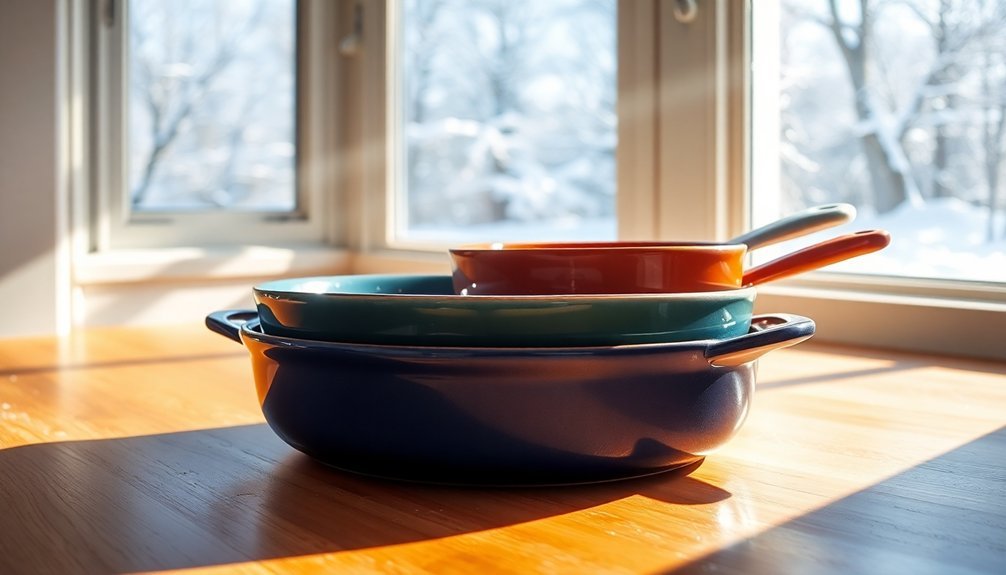
Despite shorter daylight hours in winter, you can still achieve excellent results with solar cooking by following key adjustments to your technique.
Start cooking earlier, around 10:00 AM, and reposition your cooker every 30-45 minutes to track the sun's lower arc across the sky.
Maximize heat retention by using dark-colored pots with lids and placing them on a wire rack for better air circulation.
You'll want to preheat your solar oven by positioning it to face the sun's first rays, and consider using a cast iron kettle to store heat.
Keep an oven thermometer handy to monitor temperatures without opening the door, and use a folded towel over the glass to maintain warmth.
If cooking time runs short, refrigerate your food and continue the next day.
Pan Size And Positioning
Selecting the right ceramic pan size and positioning it correctly can make or break your cooking results. For solar cooking, you'll want to choose pans that match both your meal portions and your cooker's focal point.
Dark-colored ceramic sets ranging from 2-3 pieces work best for most solar cooking needs, offering versatility while maximizing heat absorption.
Position your ceramic cookware at the center of your solar cooker between 11 AM and 3 PM, when sun intensity peaks. You'll need to adjust the position every 20-30 minutes to track the sun's movement.
- Create an air gap under your pan using a wire rack to enhance heat retention
- Place thermal mass materials around your cookware to maintain steady temperatures
- Keep reflector surfaces clean and properly angled to concentrate heat on your pan's surface
Moisture Management While Solar Cooking
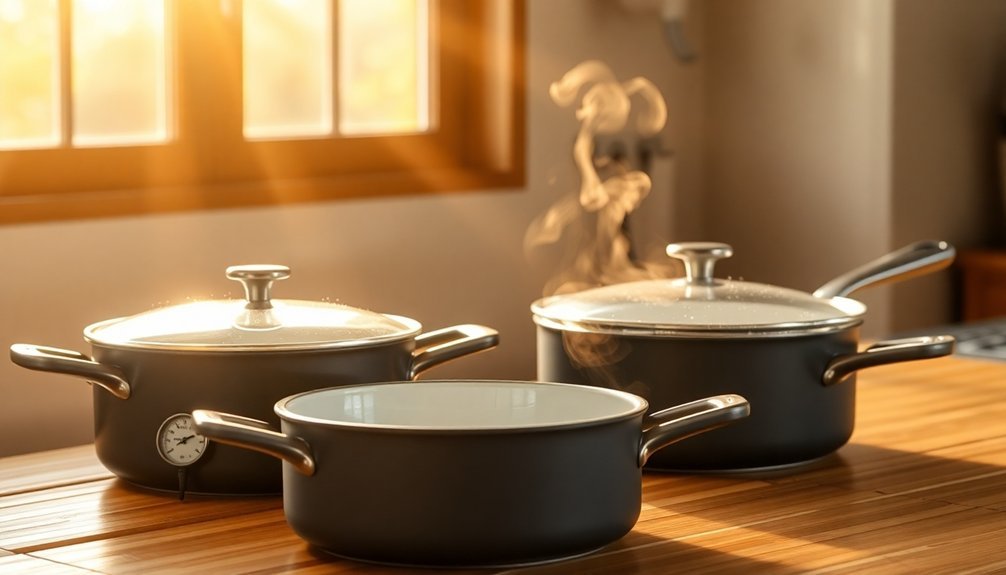
Effective moisture management during solar cooking requires understanding how different foods release water during the heating process.
When you're using ceramic pans, you'll notice that moisture naturally forms from your ingredients, especially from meats and vegetables, without adding extra liquids.
To manage condensation effectively, use lidded ceramic dishes that help retain heat while allowing some moisture control.
You can briefly prop open the solar cooker's door to release excess moisture without losing too much heat. It's also helpful to preheat your cooker and rotate it to follow the sun's path for ideal cooking conditions.
After cooking, don't forget to wipe down your solar cooker's interior to prevent mold and rust.
Clean your ceramic pans and cooker thoroughly with dish soap, ensuring everything's completely dry before storage.
Frequently Asked Questions
Can Ceramic Pans Be Used With Solar-Powered Grills and Ovens?
Yes, you can use ceramic pans in solar-powered grills and ovens. They're safe and effective due to their heat distribution properties, but you'll need to guarantee temperatures don't exceed 500°F to protect the ceramic coating.
How Do Scratches on Ceramic Pans Affect Solar Cooking Performance?
Scratches on your ceramic pans will reduce heat absorption and distribution, making your solar cooking less efficient. You'll notice longer cooking times and uneven results, as scratches disrupt the pan's ability to retain solar heat.
Will Leaving Ceramic Pans in Direct Sunlight Damage Their Nonstick Coating?
Yes, leaving your ceramic pans in direct sunlight can damage their nonstick coating. While sunlight won't directly harm the ceramic, the heat it generates can cause coating degradation and reduce your pan's lifespan over time.
Are Ceramic Pan Handles Uv-Resistant for Outdoor Solar Cooking Use?
Most ceramic pan handles aren't specifically UV-resistant. While stainless steel and silicone handles are durable, you'll want to minimize their sun exposure during solar cooking to prevent potential degradation over time.
Do Clear Glass Lids Work Better Than Ceramic Lids for Solar Cooking?
Yes, you'll get better results with clear glass lids than ceramic ones for solar cooking. They let you monitor food without opening the lid and provide excellent heat retention while allowing sunlight to pass through.
In Summary
You'll find ceramic pans transform your solar cooking experience when you select the right features and understand proper placement. Make the most of your sun-powered kitchen by choosing dark-colored, thick-bottomed pans that retain heat effectively. Remember to adjust your cooking times based on seasonal sunlight and keep moisture levels ideal. With these guidelines in mind, you're ready to harness solar energy for delicious, sustainable meals.
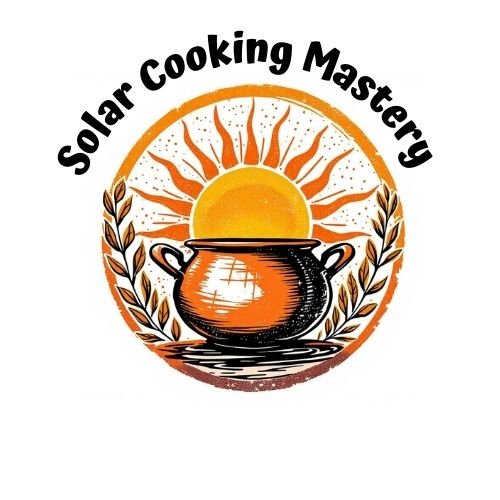
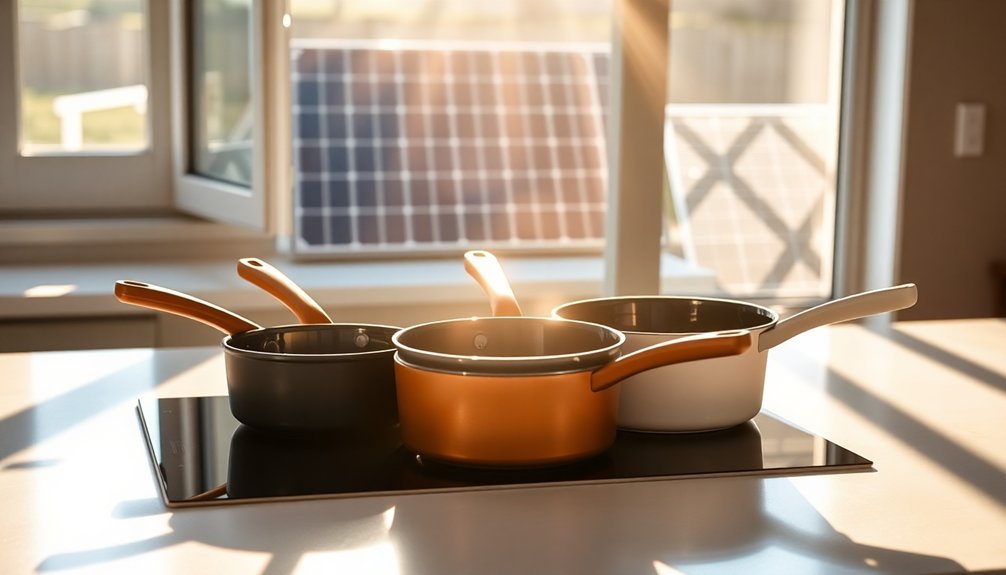
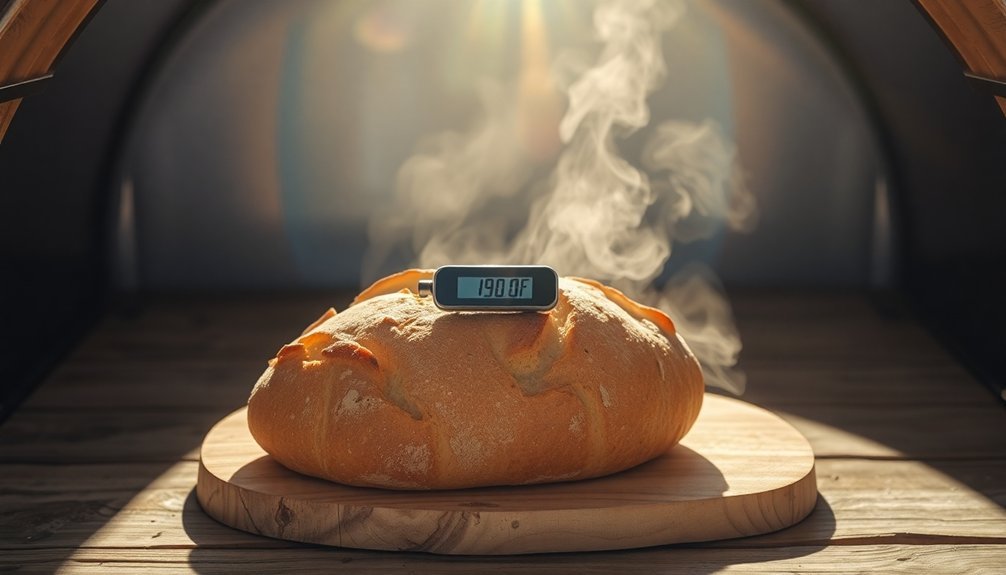
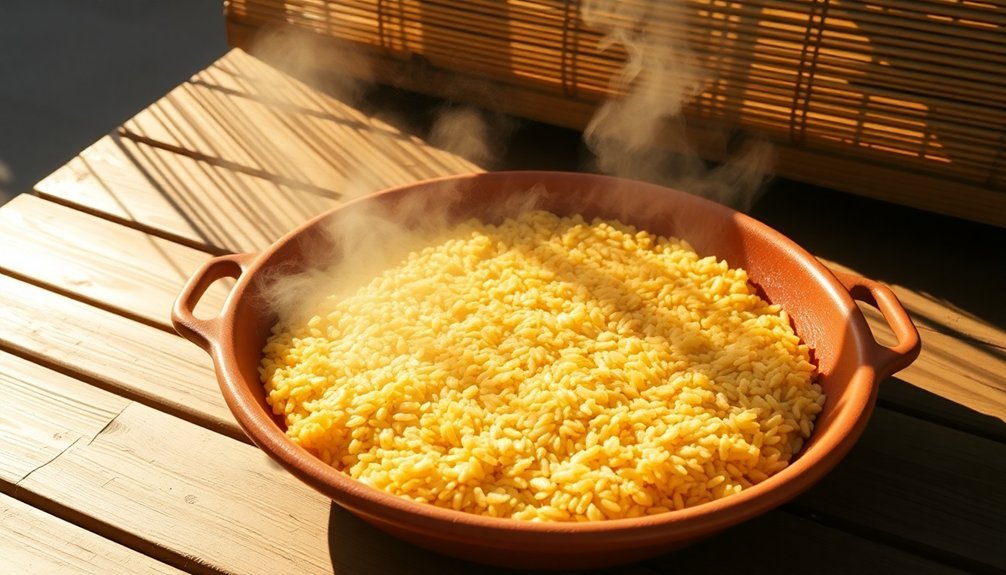
Leave a Reply